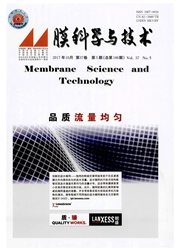

 中文摘要:
中文摘要:
以间苯二酚-甲醛为碳源,F127为添加剂,经成膜与炭化得到炭膜.通过热失重分析、红外光谱、元素分析及透射电镜从微观上分析了前驱体的热解过程及碳结构演变.采用X射线衍射及氮气吸附技术分别测定了炭膜碳结构与孔结构.研究了成膜基质表面疏水性对成膜过程的收缩率、碳结构、孔结构及气体分离性能的影响.结果显示,成膜基质对炭膜微观结构与分离性能影响显著.疏水性较大的玻璃比聚四氟乙烯与不锈钢更有助于减小成膜过程中径向收缩率,并得到高比表面积与孔体积的炭膜,其对O2/N2选择性高达10以上.
 英文摘要:
英文摘要:
Carbon membranes were prepared using resorcinol-formaldehyde as precursor and F127 as additives,through the processes of membrane-forming and carbonization.The thermal stability of precursors and their formation of carbon structure were analyzed by thermogravimetry analysis,Infrared spectroscopy,elemental analysis and transmittance electron microscopy at microscale level.The carbon structure and porous structure of carbon membranes were also measured by X-ray diffraction and N2 adsorption technique. The surface hydrophobicity of membrane-formation substrate was correlated with the shrinkage during membrane formation,carbon structure,porous structure and gas separation performance of resultant carbon membranes.Results have shown that membrane-formation substrate definitely had great effect on the microstructure and separation performance of carbon membranes.Compared with polytetrafluoroethylene and stainless steel,glass plate with higher hydrophobicity was beneficial for deceasing radial shrinkage during membrane formation,resulting into larger specific surface area and pore volume in carbon membranes.A satisfactory O2/N2 selectivity was attained above 10 for carbon membranes formed on glass plate.
 同期刊论文项目
同期刊论文项目
 同项目期刊论文
同项目期刊论文
 期刊信息
期刊信息
